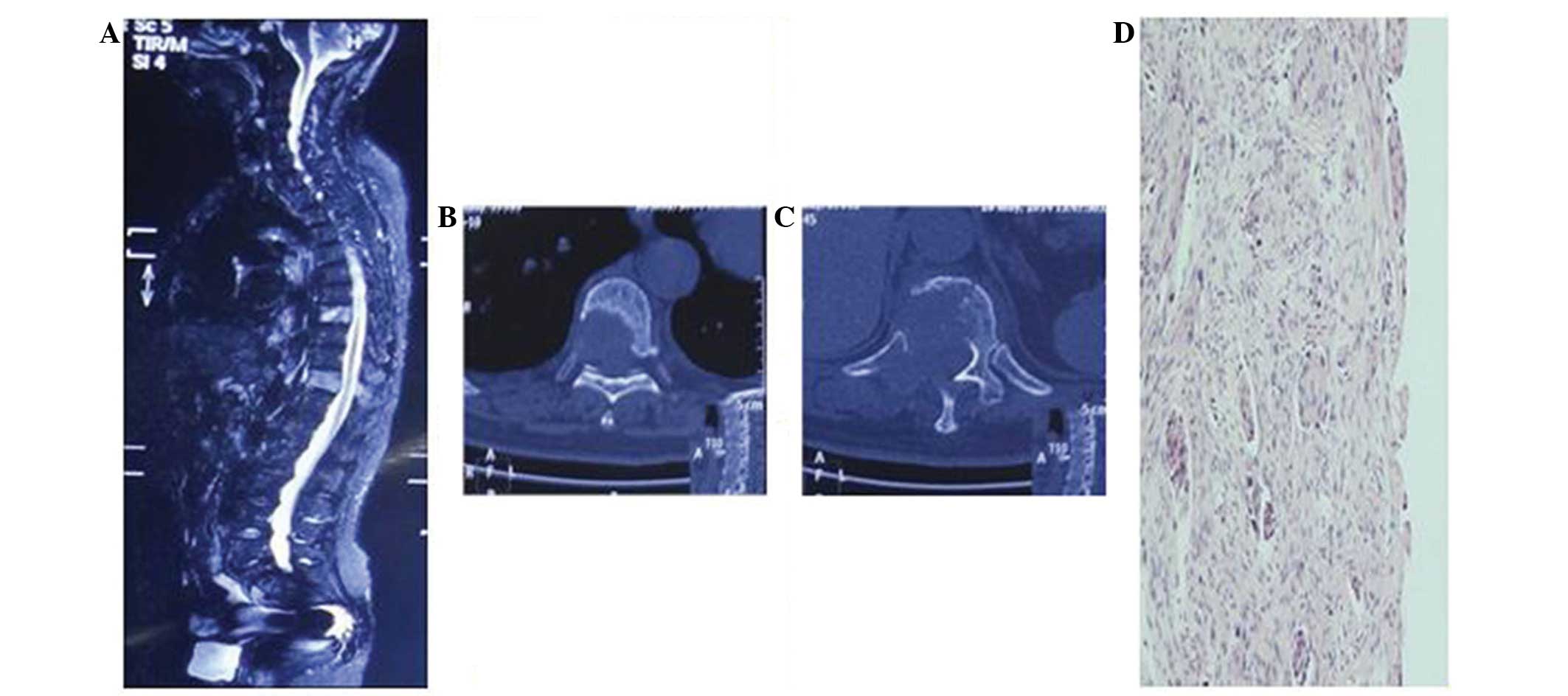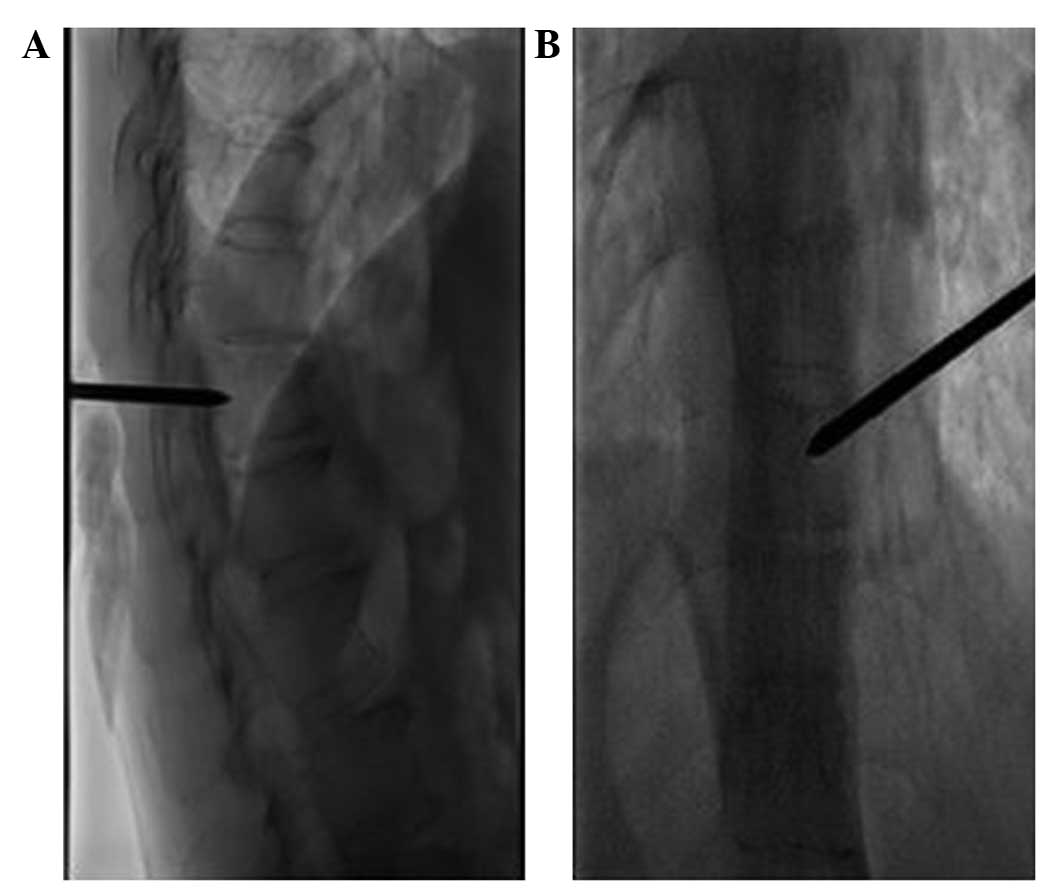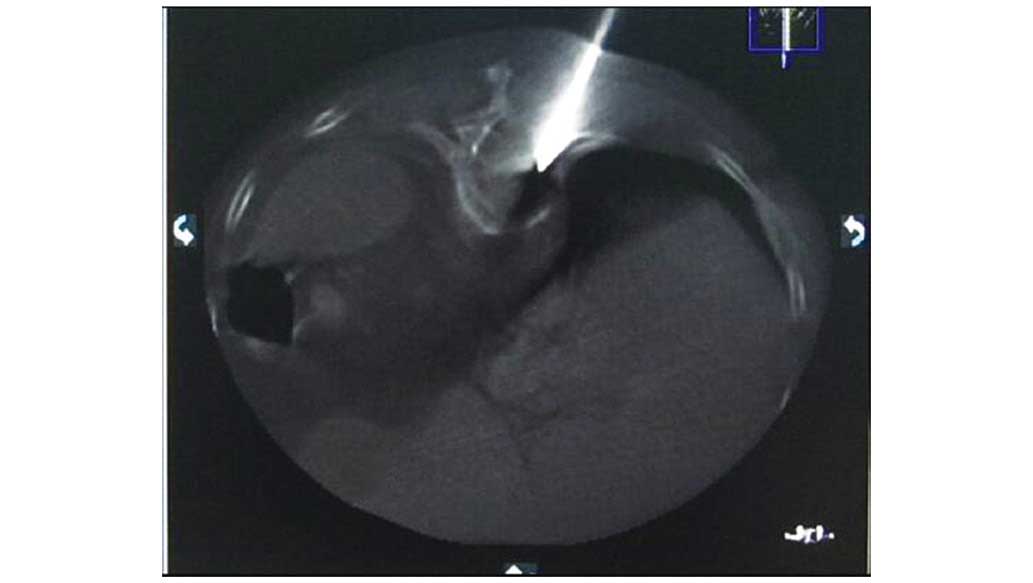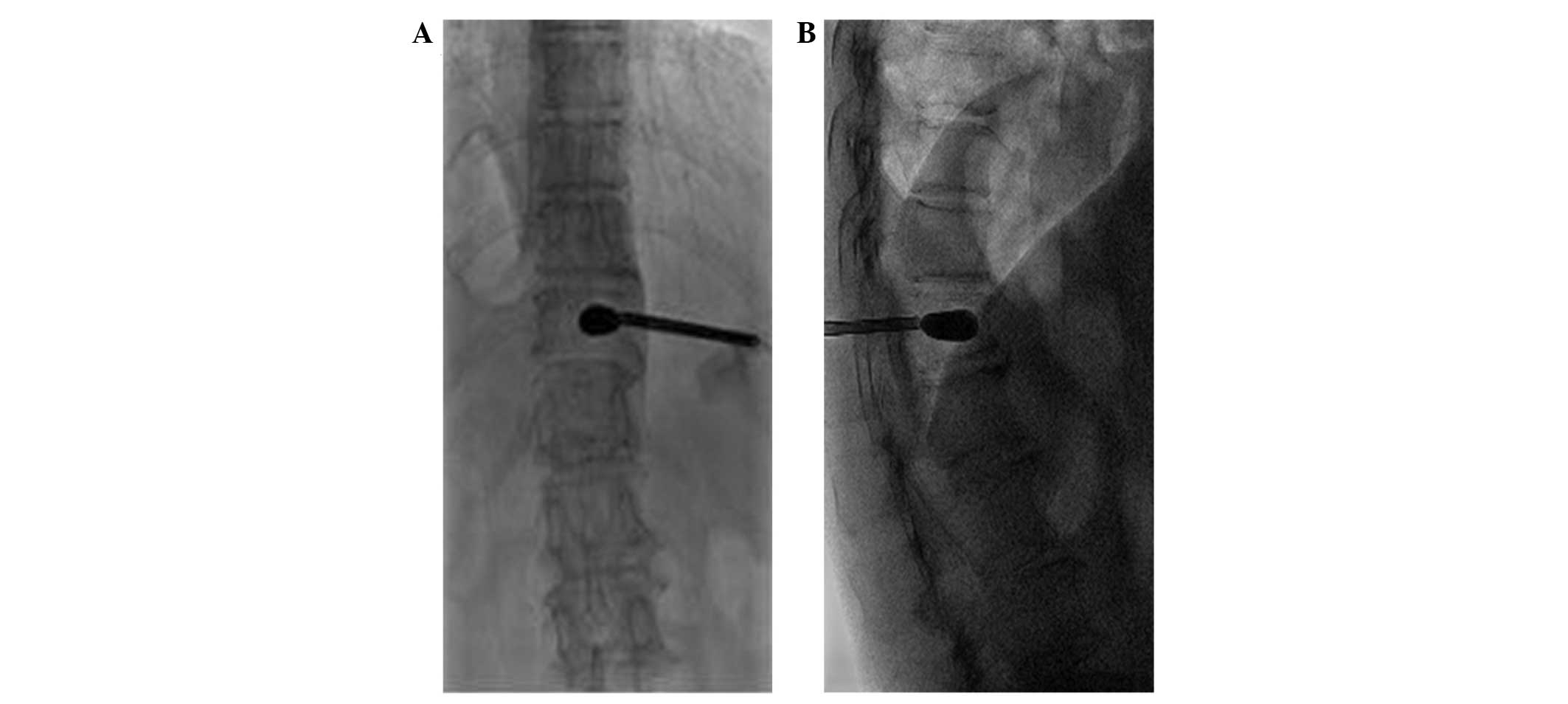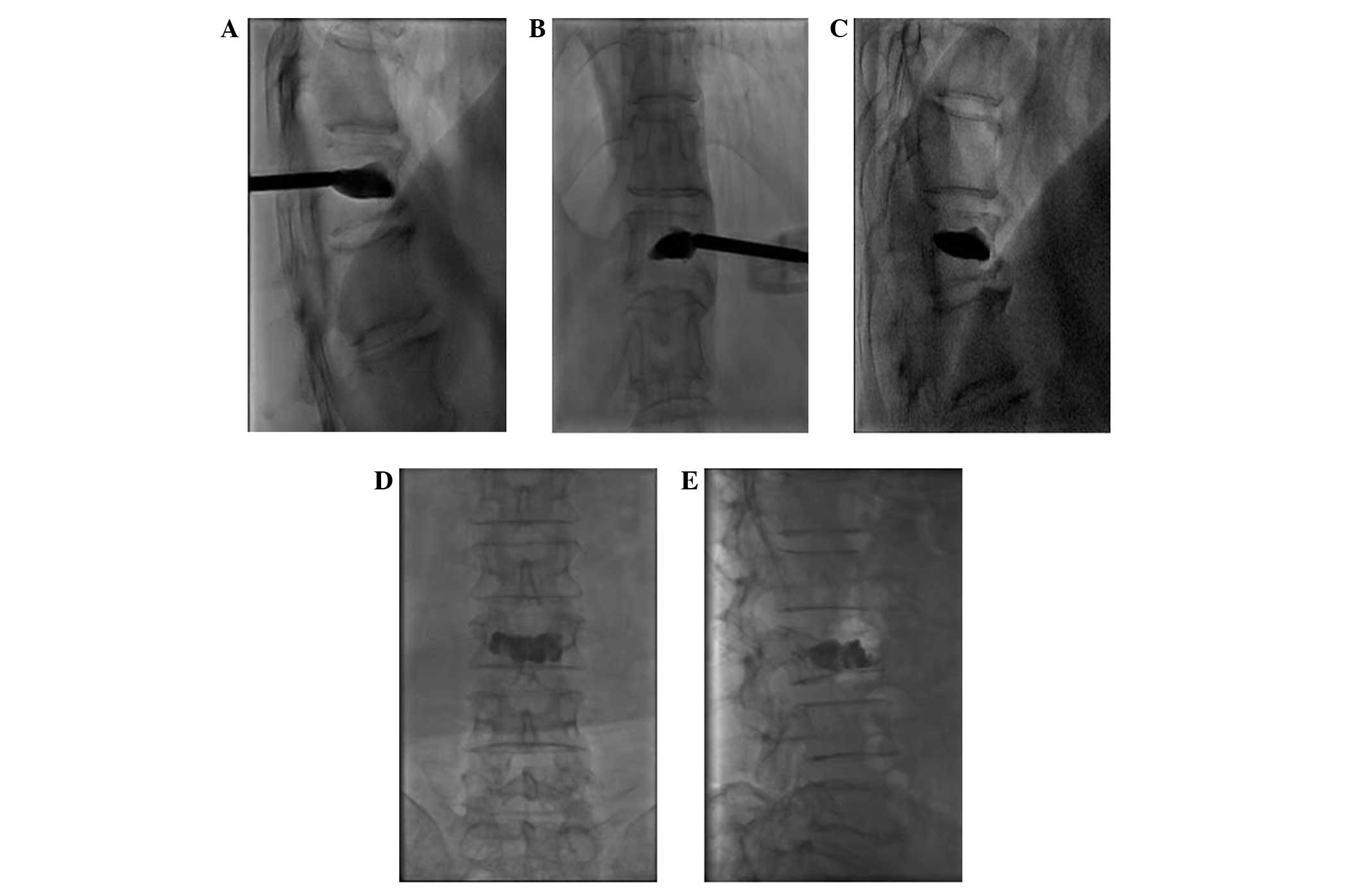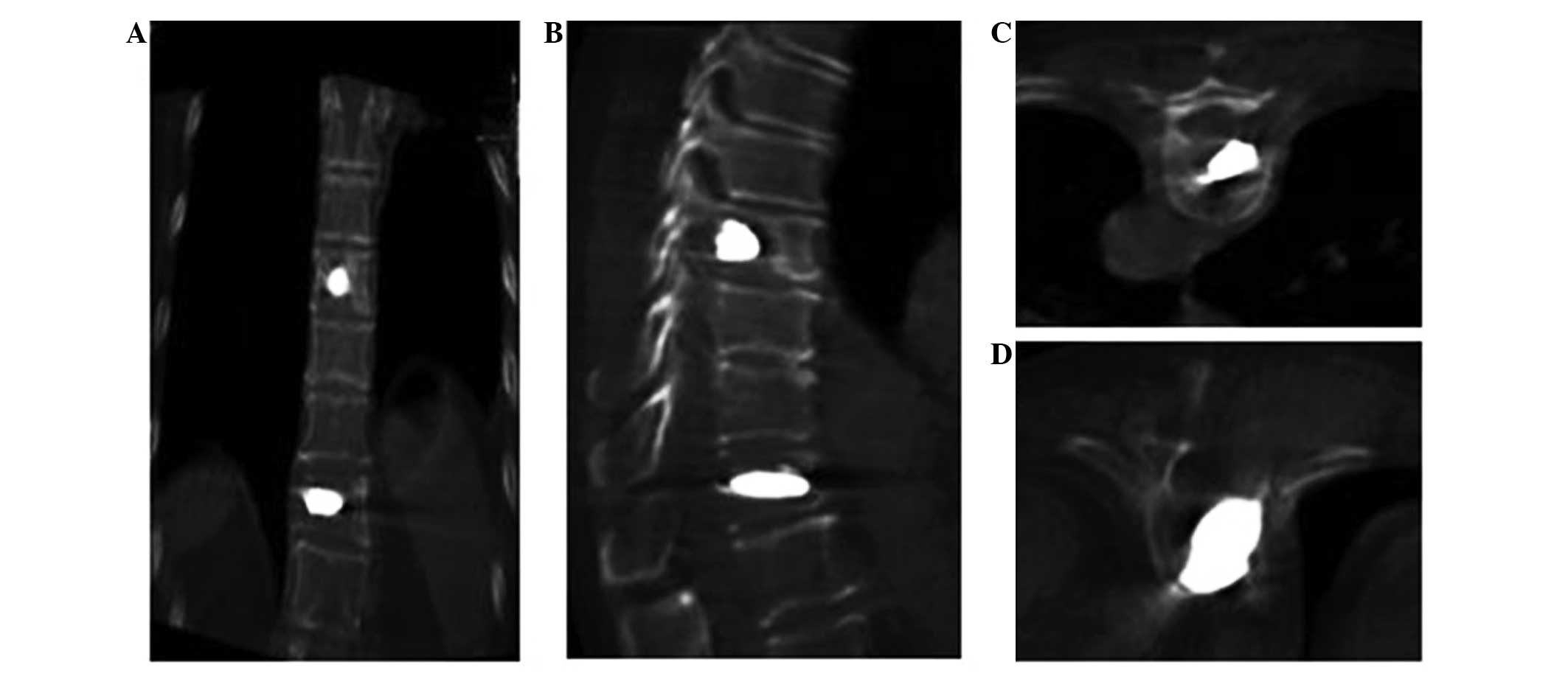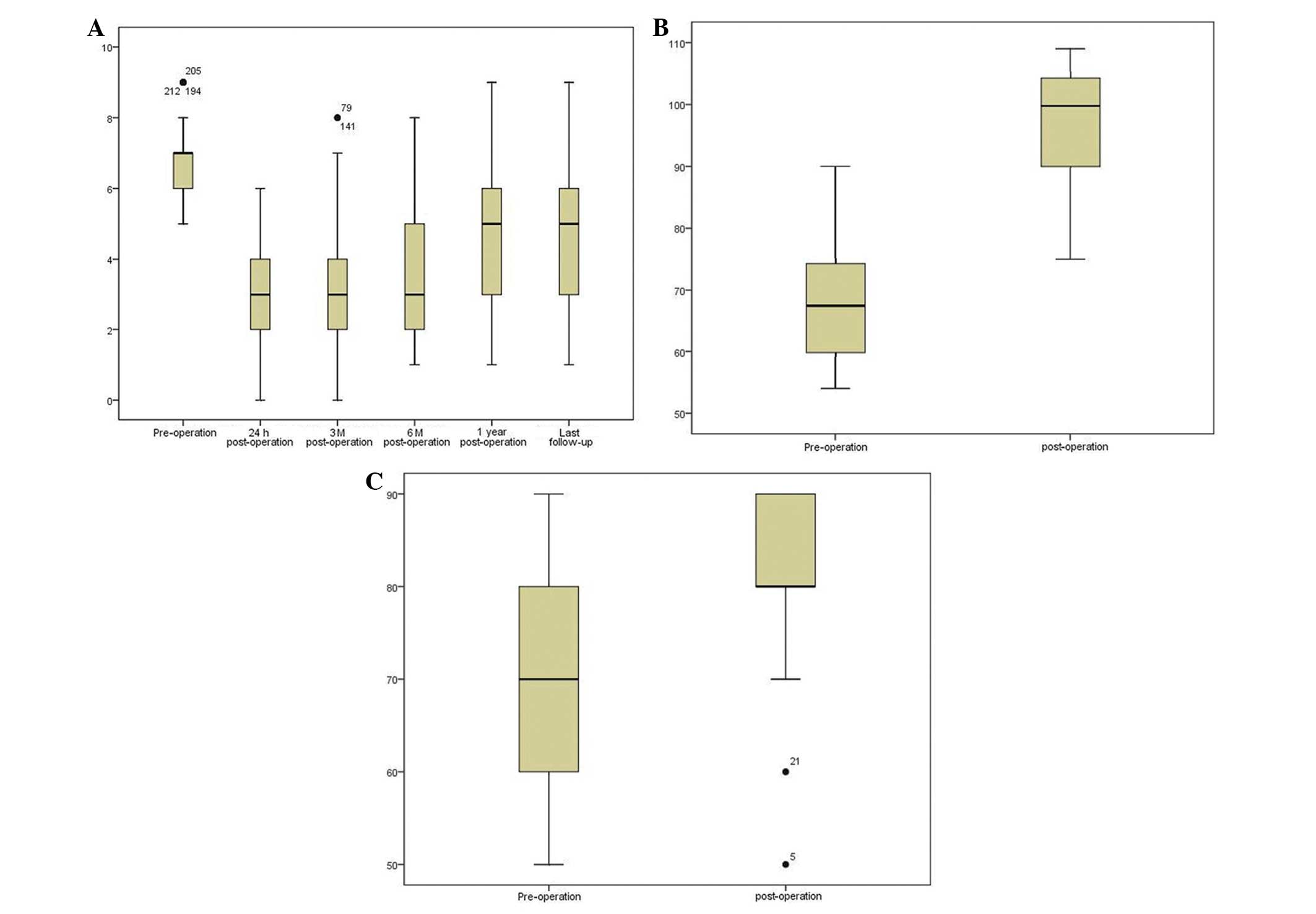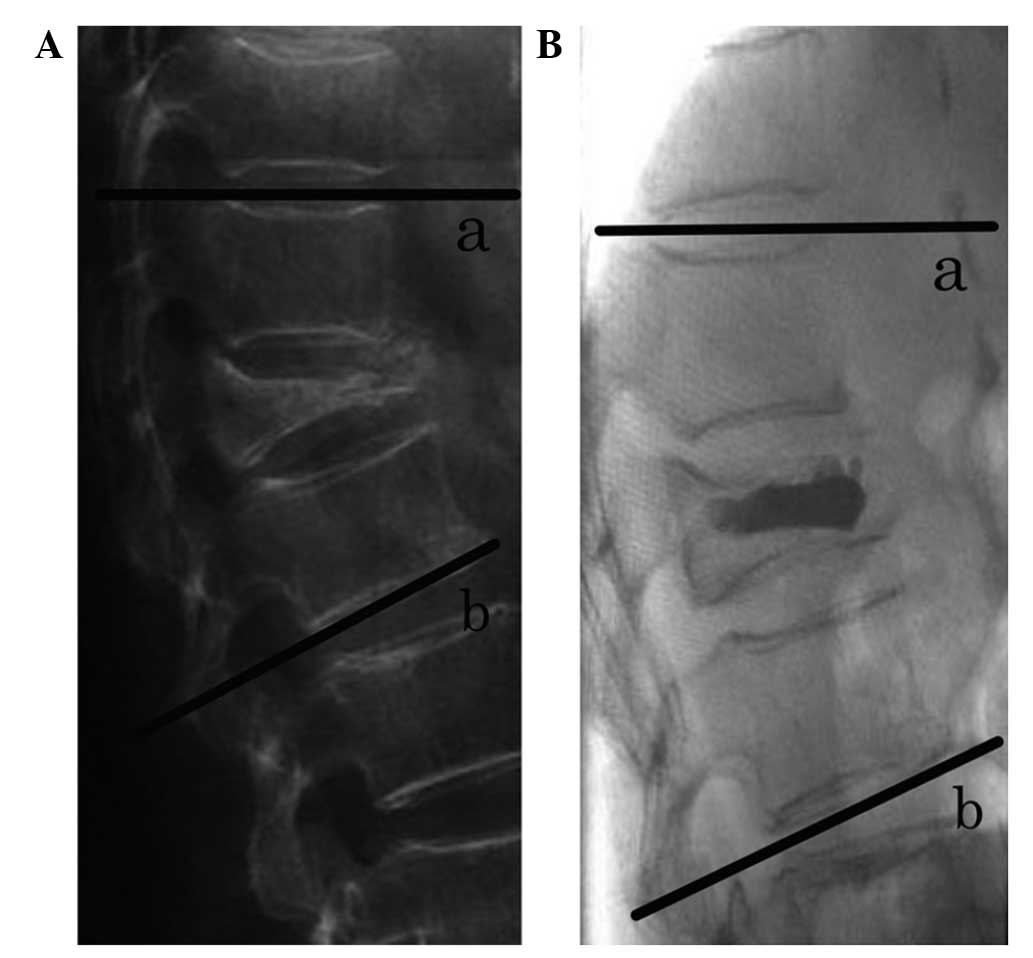|
1
|
Berrettoni BA and Carter JR: Mechanisms of
cancer metastasis to bone. J Bone Joint Surg Am. 68:308–312.
1986.PubMed/NCBI
|
|
2
|
Tatsui H, Onomura T, Morishita S, Oketa M
and Inoue T: Survival rates of patients with metastatic spinal
cancer after scintigraphic detection of abnormal radioactive
accumulation. Spine. 21:2143–2148. 1996. View Article : Google Scholar : PubMed/NCBI
|
|
3
|
Chi JH and Gokaslan ZL: Vertebroplasty and
kyphoplasty for spinal metastases. Curr Opin Support Palliat Care.
2:9–13. 2008. View Article : Google Scholar : PubMed/NCBI
|
|
4
|
Georgy BA: Metastatic spinal lesions:
State-of-the-art treatment options and future trends. AJNR Am J
Neuroradiol. 29:1605–1611. 2008. View Article : Google Scholar : PubMed/NCBI
|
|
5
|
Yang ZZ, Xu JB, Yuan T, Qian BS, Zhang JY,
Li WZ, Li JL, Xiao YB, Peng M, Li Y and Luan L: Treating metastatic
vertebral tumor with percutaneous vertebroplasty: A report of 28
cases. Ai Zheng. 24:194–198. 2005.(In Chinese). PubMed/NCBI
|
|
6
|
Zhang HT, Chen GD, Yang HL and Luo ZP:
Percutaneous kyphoplasty in the treatment of osteoblastic-related
spinal metastases. J Spinal Disord Tech: Jul. 26:2013.(Epub ahead
of print).
|
|
7
|
Qian Z, Sun Z, Yang H, Gu Y, Chen K and Wu
G: Kyphoplasty for the treatment of malignant vertebral compression
fractures caused by metastases. J Clin Neurosci. 18:763–767. 2011.
View Article : Google Scholar : PubMed/NCBI
|
|
8
|
Dudeney S, Lieberman IH, Reinhardt MK and
Hussein M: Kyphoplasty in the treatment of osteolytic vertebral
compression fractures as a result of multiple myeloma. J Clin
Oncol. 20:2382–2387. 2002. View Article : Google Scholar : PubMed/NCBI
|
|
9
|
Lieberman IH, Dudeney S, Reinhardt MK and
Bell G: Initial outcome and efficacy of ‘kyphoplasty’ in the
treatment of painful osteoporotic vertebral compression fractures.
Spine. 26:1631–1638. 2001. View Article : Google Scholar : PubMed/NCBI
|
|
10
|
Bouza C, López T, Magro A, Navalpotro L
and Amate JM: Efficacy and safety of balloon kyphoplasty in the
treatment of vertebral compression fractures: A systematic review.
Eur Spine J. 15:1050–1067. 2006. View Article : Google Scholar : PubMed/NCBI
|
|
11
|
Frankel HL, Hancock DO, Hyslop G, Melzak
J, Michaelis LS, Ungar GH, Vernon JD and Walsh JJ: The value of
postural reduction in the initial management of closed injuries of
the spine with paraplegia and tetraplegia. I. Paraplegia.
7:179–192. 1969. View Article : Google Scholar : PubMed/NCBI
|
|
12
|
Ware JE, Snow KK, Kosinski M and Gandek B:
SF-36 Health Survey: Manual and Interpretation Guide. The Health
Institute (Boston, MA). New England Medical Center. 1993.
|
|
13
|
Newnham EA, Harwood KE and Page AC:
Evaluating the clinical significance of responses by psychiatric
inpatients to the mental health subscales of the SF-36. J Affective
Disord. 98:91–97. 2007. View Article : Google Scholar
|
|
14
|
Bai GT, Ma YW and Jiang L: Application
progress of SF-36 at home and abroad. J Clin Res. 12:2367–2368.
2009.(In Chinese).
|
|
15
|
Cobb J: Outline for the study of
scoliosis. AAOS Instr Course Lect. 5:261–275. 1948.
|
|
16
|
Bienz M and Saad F: Management of bone
metastases in prostate cancer: A review. Curr Opin Support Palliat
Care. 9:261–267. 2015. View Article : Google Scholar : PubMed/NCBI
|
|
17
|
Silverman SL: The clinical consequences of
vertebral compression fracture. Bone. 13(Suppl 2): S27–S31. 1992.
View Article : Google Scholar : PubMed/NCBI
|
|
18
|
McDonald R, Chow E, Rowbottom L, Bedard G,
Lam H, Wong E, Popovic M, Pulenzas N and Tsao M: Quality of life
after palliative radiotherapy in bone metastases: A literature
review. J Bone Oncol. 4:24–31. 2014. View Article : Google Scholar : PubMed/NCBI
|
|
19
|
Yang Z, Yang D, Xie L, Sun Y, Huang Y, Sun
H, Liu P and Wu Z: Treatment of metastatic spinal tumors by
percutaneous vertebroplasty versus percutaneous vertebroplasty
combined with interstitial implantation of 125I seeds. Acta Radiol.
50:1142–1148. 2009. View Article : Google Scholar : PubMed/NCBI
|
|
20
|
Li Y, Gu YF, Sun ZK, Wu CG, Li YD, Wang W,
Chen YC and Lu J: Comparison of percutaneous vertebroplasty with
and without interventional tumour removal for malignant vertebral
compression fractures with symptoms of neurological compression.
Eur Radiol. 23:2754–2763. 2013. View Article : Google Scholar : PubMed/NCBI
|
|
21
|
Taylor JW and Schiff D: Metastatic
epidural spinal cord compression. Semin Neurol. 30:245–253. 2010.
View Article : Google Scholar : PubMed/NCBI
|
|
22
|
Shimony JS, Gilula LA, Zeller AJ and Brown
DB: Percutaneous vertebroplasty for malignant compression fractures
with epidural involvement. Radiology. 232:846–853. 2004. View Article : Google Scholar : PubMed/NCBI
|
|
23
|
Sun G, Jin P, Li M, et al: Percutaneous
vertebroplasty for pain management in spinal metastasis with
epidural involvement. Technol Cancer Res Treat. 10:267–274.
2011.PubMed/NCBI
|
|
24
|
Cotten A, Dewatre F, Cortet B, Assaker R,
Leblond D, Duquesnoy B, Chastanet P and Clarisse J: Percutaneous
vertebroplasty for osteolytic metastases and myeloma: Effects of
the percentage of lesion filling and the leakage of methyl
methacrylate at clinical follow-up. Radiology. 200:525–530. 1996.
View Article : Google Scholar : PubMed/NCBI
|
|
25
|
Cortet B, Cotton A, Boutry N, Dewatre F,
Flipo RM, Duquesnoy B, Chastanet P and Delcambre B: Percutaneous
vertebroplasty in patients with osteolytic metastases or multiple
myeloma. Rev Rev Rhum Engl Ed. 64:177–183. 1997.PubMed/NCBI
|
|
26
|
Yu C-W, Hsieh M-K, Chen LH, et al:
Percutaneous balloon kyphoplasty for the treatment of vertebral
compression fractures. BMC Surg. 14:32014. View Article : Google Scholar : PubMed/NCBI
|
|
27
|
Voggenreiter G: Balloon kyphoplasty is
effective in deformity correction of osteoporotic vertebral
compression fractures. Spine. 30:2806–2812. 2005. View Article : Google Scholar : PubMed/NCBI
|
|
28
|
Ledlie JT and Renfro MB: Kyphoplasty
treatment of vertebral fractures: 2-year outcomes show sustained
benefits. Spine. 31:57–64. 2006. View Article : Google Scholar : PubMed/NCBI
|
|
29
|
Phillips FM, Ho E, Campbell-Hupp M,
McNally T, Wetzel Todd F and Gupta P: Early radiographic and
clinical results of balloon kyphoplasty for the treatment of
osteoporotic vertebral compression fractures. Spine. 28:2260–2267.
2003. View Article : Google Scholar : PubMed/NCBI
|
|
30
|
Fourney DR, Schomer DF, Nader R,
Chlan-Fourney J, Suki D, Ahrar K, Rhines LD and Gokaslan ZL:
Percutaneous vertebroplasty and kyphoplasty for painful vertebral
body fractures in cancer patients. J Neurosurg. 98(Suppl): 21–30.
2003.PubMed/NCBI
|
|
31
|
Pflugmacher R, Schleicher P, Schröder RJ,
Melcher I and Klostermann CK: Maintained pain reduction in five
patients with multiple myeloma 12 months after treatment of the
involved cervical vertebrae with vertebroplasty. Acta Radiol.
47:823–829. 2006. View Article : Google Scholar : PubMed/NCBI
|
|
32
|
Eck JC, Nachtigall D, Humphreys SC and
Hodges SD: Comparison of vertebroplasty and balloon kyphoplasty for
treatment of vertebral compression fractures: A meta-analysis of
the literature. Spine J. 8:488–497. 2008. View Article : Google Scholar : PubMed/NCBI
|
|
33
|
Cotten A, Boutry N, Cortet B, Assaker R,
Demondion X, Leblond D, Chastanet P, Duquesnoy B and Deramond H:
Percutaneous vertebroplasty: State of the art. Radiographics.
18:311–323. 1998. View Article : Google Scholar : PubMed/NCBI
|
|
34
|
Deramond H, Depriester C, Galibert P and
Le Gars D: Percutaneous vertebroplasty with polymethylmethacrylate.
Technique, indications, and results. Radiol Clin North Am.
36:533–546. 1998. View Article : Google Scholar : PubMed/NCBI
|
|
35
|
Garfin SR, Yuan HA and Reiley MA: New
technologies in spine: Kyphoplasty and vertebroplasty for the
treatment of painful osteoporotic compression fractures. Spine.
26:1511–1515. 2001. View Article : Google Scholar : PubMed/NCBI
|















